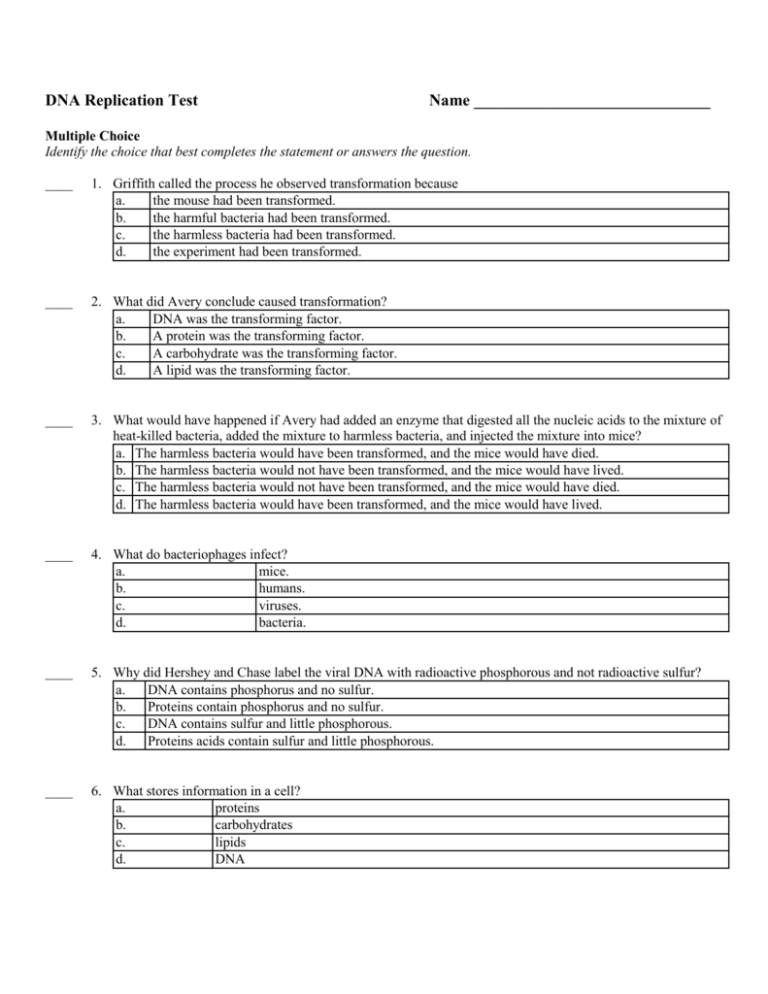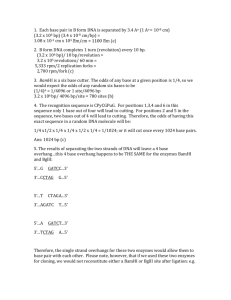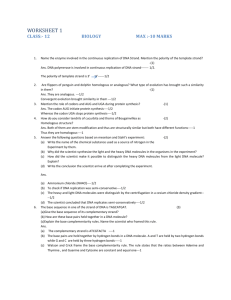DNA Replication Test
advertisement

DNA Replication Test Name _____________________________ Multiple Choice Identify the choice that best completes the statement or answers the question. ____ 1. Griffith called the process he observed transformation because a. the mouse had been transformed. b. the harmful bacteria had been transformed. c. the harmless bacteria had been transformed. d. the experiment had been transformed. ____ 2. What did Avery conclude caused transformation? a. DNA was the transforming factor. b. A protein was the transforming factor. c. A carbohydrate was the transforming factor. d. A lipid was the transforming factor. ____ 3. What would have happened if Avery had added an enzyme that digested all the nucleic acids to the mixture of heat-killed bacteria, added the mixture to harmless bacteria, and injected the mixture into mice? a. The harmless bacteria would have been transformed, and the mice would have died. b. The harmless bacteria would not have been transformed, and the mice would have lived. c. The harmless bacteria would not have been transformed, and the mice would have died. d. The harmless bacteria would have been transformed, and the mice would have lived. ____ 4. What do bacteriophages infect? a. mice. b. humans. c. viruses. d. bacteria. ____ 5. Why did Hershey and Chase label the viral DNA with radioactive phosphorous and not radioactive sulfur? a. DNA contains phosphorus and no sulfur. b. Proteins contain phosphorus and no sulfur. c. DNA contains sulfur and little phosphorous. d. Proteins acids contain sulfur and little phosphorous. ____ 6. What stores information in a cell? a. proteins b. carbohydrates c. lipids d. DNA Figure 12–1 ____ 7. Which part of the bacteriophage in Figure 12–1 contains genetic material? a. A b. B c. C d. D ____ 8. What happens when a piece of DNA is missing? a. Genetic information is stored. b. Genetic information is copied. c. Genetic information is lost. d. Genetic information is transmitted. ____ 9. In what way is DNA like a book? a. DNA has information organized with an kind of index. b. DNA has stored information, that can be copied and passed on. c. DNA has information wrapped in an identifying cover. d. DNA has information that is periodically updated. ____ 10. In which cells is the accurate transmission of information most important? a. nerve cells b. skin cells c. sex cells d. bone cells ____ 11. Which of the following is a nucleotide found in DNA? a. adenine + phosphate group + thymine b. cytosine + phosphate group + guanine c. deoxyribose + phosphate group + polymerase d. deoxyribose + phosphate group + cytosine Nitrogenous Bases (%) Human Chicken Bacterium (S. lutea) A 28.8 2 13.4 Figure 12–3 G 19.9 T 29.4 C 21.5 ____ 12. The table in Figure 12–3 shows the results of measuring the percentages of the four bases in the DNA of several different organisms. Some of the values are missing from the table. Based on Chargaff’s rule, the percentages of guanine bases in chicken DNA should be around a. 28.8% b. 19.9% c. 21.5% d. 13.4% ____ 13. Based on Chargaff’s rule, the percentage of cytosine in the DNA of the bacterium, S. Lutea in Figure 12–3, should be around a. 26.6%. b. 73.2%. c. 36.6%. d. 29.4%. ____ 14. DNA makes a good molecule for storing information because a. its bases can be joined together in any order, like the letters of the alphabet can be strung to form different words. b. each nucleotide within a DNA strand can give a cell different information, and there are many nucleotides in every cell. c. it can absorb ultraviolet light, so DNA can help protect cells from the damaging effects of this form of radiation. d. it is a type of nucleic acid, and most acids are an important part of information storage within cells. ____ 15. Which of the following best describes Rosalind Franklin’s contribution to our understanding of the structure of DNA? a. She created many models of DNA based on what was known about its properties, and eventually figured out that the structure of DNA is a double helix. b. She purified large amounts of DNA, stretched the fibers so the strands were parallel, and used an X-ray beam to produce an image of the molecule. c. She isolated DNA from many different organisms, and discovered that in every sample, the amount of guanine was almost exactly equal to the amount of cytosine. d. She used radioactive phosphorus and sulfur to produce radioactive viruses, then allowed these viruses to infect bacteria. She found that DNA was the transforming material. ____ 16. Which scientist(s) figured out that the shape of a DNA molecule is a double helix? a. Hershey and Chase b. Griffith c. Watson and Crick d. Franklin ____ 17. Which scientist made x-ray diffraction photos of DNA? a. Franklin b. Chargaff c. Watson d. Avery ____ 18. DNA replication results in two DNA molecules, a. each with two new strands. b. one with two new strands and the other with two original strands. c. each with one new strand and one original strand. d. each with two original strands. ____ 19. During DNA replication, a DNA strand that has the bases CTAGGT produces a strand with the bases a. TCGAAC. b. GATCCA. c. AGCTTG. d. GAUCCA. ____ 20. What enzyme works to add DNA to ends of chromosomes in rapidly dividing cells such as those found in an embryo, to prevent genes from being lost during replication? a. DNA polymerase b. histones c. telomerase d. chromatin ____ 21. In eukaryotes, DNA a. is located in the nucleus. b. floats freely in the cytoplasm. c. is located in the ribosomes. d. is circular. ____ 22. In both prokaryotes and eukaryotes, how many copies of the chromosome are left after replication? a. b. c. d. 1 2 3 4 ____ 23. In both prokaryotes and eukaryotes, DNA replication happens a. before cell division. b. in the nucleus. c. only to telomeres. d. around the histones. ____ 24. RNA contains the sugar a. ribose. b. deoxyribose. c. glucose. d. lactose. ____ 25. Unlike DNA, RNA contains a. adenine. b. uracil. c. phosphate groups. d. thymine. ____ 26. Which of the following are found in both DNA and RNA? a. ribose, phosphate groups, and adenine b. deoxyribose, phosphate groups, and guanine c. phosphate groups, guanine, and cytosine d. phosphate groups, guanine, and thymine ____ 27. Which of the following is true? a. RNA is usually single-stranded. b. DNA is usually single-stranded. c. DNA contains uracil. d. RNA contains thymine. ____ 28. Which type of RNA brings the information in the genetic code from the nucleus to other parts of the cell? a. rRNA b. tRNA c. mRNA d. RNA polymerase ____ 29. Which molecules are involved in protein synthesis? a. transfer RNA, introns, and mutagens b. messenger RNA, introns, and ribosomal RNA c. ribosomal RNA, transfer RNA, and mutagens d. messenger RNA, ribosomal RNA, and transfer RNA ____ 30. From which molecules are mRNA molecules transcribed? a. tRNA b. rRNA c. DNA d. proteins ____ 31. What is produced during transcription? a. RNA molecules b. DNA molecules c. RNA polymerase d. proteins Figure 13–2 ____ 32. What does Figure 13–2 show? a. b. c. d. anticodons exons introns the genetic code ____ 33. According to Figure 13–2, which code specifies the same amino acid as UAU? a. UAC b. UAA c. UGC d. UGU ____ 34. How many nucleotides are needed to specify three amino acids? a. 3 b. 6 c. 9 d. 12 ____ 35. What happens during translation? a. Messenger RNA is made from a DNA code. b. The cell uses a messenger RNA code to make proteins. c. Transfer RNA is made from a messenger RNA code. d. Copies of DNA molecules are made. ____ 36. During translation, the type of amino acid that is added to the growing polypeptide depends on the a. codon on the mRNA and the anticodon on the rRNA. b. anticodon on the mRNA and the anticodon on the tRNA. c. anticodon on the rRNA and the codon on the mRNA. d. codon on the mRNA and the anticodon on the tRNA. ____ 37. Genes contain instructions for assembling a. operons. b. nucleosomes. c. proteins. d. mutagens. ____ 38. Which is the correct sequence of the transfer of information in most organisms? a. protein to DNA to RNA b. RNA to DNA to protein c. DNA to RNA to protein d. RNA to protein to DNA Completion Complete each statement. 39. Eukaryotic DNA molecules need to be carefully copied and sorted, especially in the formation of ____________________________________________ cells during meiosis. 40. The Watson and Crick model of DNA is a(an) ________________________________________, in which two strands are wound around each other. 41. If covalent bonds held the two strands of nucleotides together, the two strands could not easily separate and ____________________________________________. 42. The order of nitrogenous bases in DNA determines the order of ___________________________ in proteins. 43. The codon that signals the end of a growing polypeptide is called a(an) ____________________________________________. 44. The tRNA bases called the _______________________________________ are complementary to three consecutive nucleotides on an mRNA molecule. Short Answer 45. How did X-ray technology enable scientists to better understand the structure of DNA? 46. If the percentage of guanine in the DNA of a certain species decreased by 5 percent over time, what would you expect to have happened to the percentage of adenine in that DNA? Figure 13–6 47. What is molecule B in Figure 13–6, and what is its function? 48. What are the three main parts of an RNA nucleotide? Figure 13–2 49. According to Figure 13–2, what codons specify the amino acid glycine? 50. Within a cell, where does translation take place? DNA Replication Test Answer Section MULTIPLE CHOICE 1. ANS: C 2. ANS: A 3. ANS: B 4. ANS: D 5. ANS: A 6. ANS: D 7. ANS: B 8. ANS: C 9. ANS: B 10. ANS: C 11. ANS: D 12. ANS: C 13. ANS: C 14. ANS: A 15. ANS: B 16. ANS: C 17. ANS: A 18. ANS: C 19. ANS: B 20. ANS: D 21. ANS: A 22. ANS: B 23. ANS: A 24. ANS: A 25. ANS: B 26. ANS: C 27. ANS: A 28. ANS: C 29. ANS: D 30. ANS: C 31. ANS: A 32. ANS: D 33. ANS: A 34. ANS: C 35. ANS: B 36. ANS: D 37. ANS: C 38. ANS: C COMPLETION 39. ANS: reproductive 40. ANS: double helix 41. ANS: replicate 42. ANS: amino acids 43. ANS: stop codon 44. ANS: anticodons SHORT ANSWER 45. ANS: Rosalind Franklin used powerful X-ray beams to make diffraction photographs that gave Watson and Crick the clues they needed to determine DNA’s structure. 46. ANS: The percentage of adenine would have increased by about 5 percent. 47. ANS: Molecule B is tRNA, which carries amino acids to the ribosomes. 48. ANS: A ribose molecule, a phosphate group, and a nitrogenous base are the three main parts of an RNA nucleotide. 49. ANS: GGU, GGC, GGA, and GGG specify glycine. 50. ANS: Translation takes place on ribosomes in the cytoplasm.









